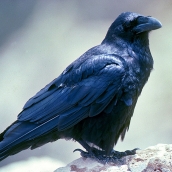Common Raven (Corvus corax)
Bird up to 56-67 cm long, wingspan 115-130 cm, noted for its entirely black plumage and large beak, and for its strong hoarse croak. It is the largest raven in Macaronesia and in all the Western Palaearctic. In this region, it is only found in the Canary Islands, where the subspecies C. c. canariensis is considered endemic to the archipelago, although these populations are occasionally assigned to C. c. tingitanus from North Africa. It lives on all the islands and several islets (Alegranza, Montaña Clara, La Graciosa and Lobos), preferring rocky crags, cliffs, large ravines and inland peaks, but it also breeds in relatively flat open pine forests. It is found at altitudes above 2,000 m on La Palma and Tenerife, although much less so on the latter. It frequents rubbish dumps, arable lands and recreational areas in search of food, as well as roads, where it feeds on roadkill. The diet of this omnivorous bird is composed of carrion, insects, snails, mice, reptiles (mainly lizards) and birds’ eggs; it also plays a vital role in seed dispersal by feeding on the fruits of native vascular plants (e.g., juniper). The breeding seasons runs from February to June, although clutches of 3-7 eggs are mainly produced in March and April. Nests are large and solid, generally located in rocky walls and, to a lesser extent, in trees and electricity pylons. The raven is very gregarious outside of the breeding season, occasionally gathering in sizeable flocks that fly over large areas. Though abundant in the past, the species is now only common on some islands, such as Fuerteventura and El Hierro, and is more scarce on Lanzarote and neighbouring islets. Populations have declined drastically in La Palma (17 pairs), La Gomera (5), Tenerife (12) and Gran Canaria (10), according to a census carried out in 2009. Conversely, in Fuerteventura alone there appear to be over 100 pairs. Since the 1980s, populations have shrunk noticeably by as much as 83%-85% in Tenerife and 95% in La Gomera. Consequently, these birds are considered endangered on most of the Canary Islands. Main threats include diminished food sources, poisons used in farming, poaching, collisions with overhead cables, a changing and fragmented habitat, human interference in nesting areas and competition with seagulls. The validity of the subspecies C. c. canariensis urgently requires confirming because of important implications for conservation.













